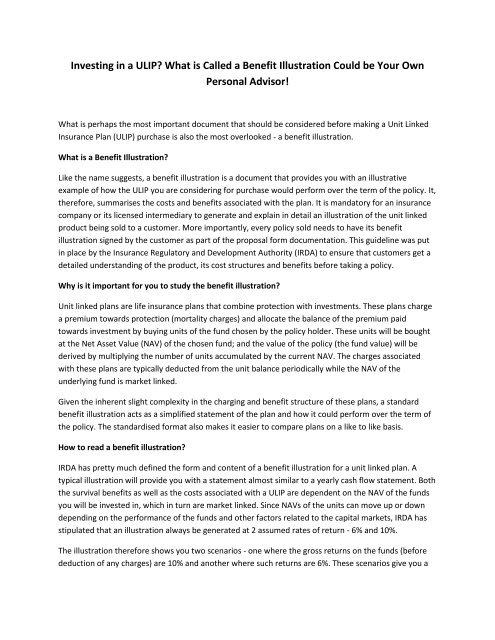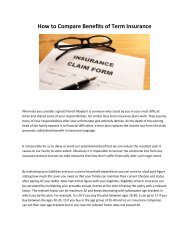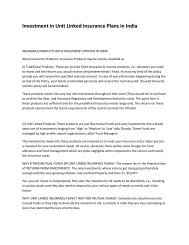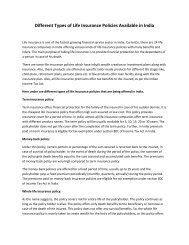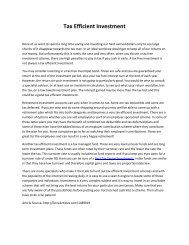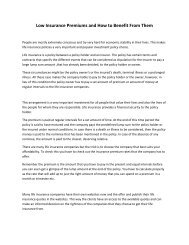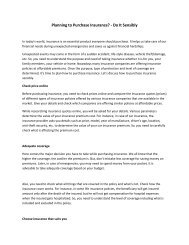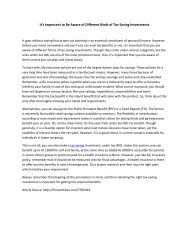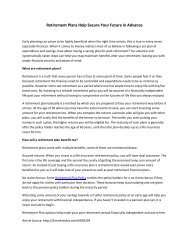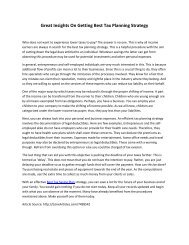Investing in a ULIP What is Called a Benefit Illustration Could be Your Own Personal Advisor
ULIP plans offer the flexibility of market linked returns on your investments and life insurance cover for you and your family. Click to know more https://www.bajajallianzlife.com/ulip/ulip.jsp
ULIP plans offer the flexibility of market linked returns on your investments and life insurance cover for you and your family. Click to know more https://www.bajajallianzlife.com/ulip/ulip.jsp
You also want an ePaper? Increase the reach of your titles
YUMPU automatically turns print PDFs into web optimized ePapers that Google loves.
<strong>Invest<strong>in</strong>g</strong> <strong>in</strong> a <strong>ULIP</strong>? <strong>What</strong> <strong>is</strong> <strong>Called</strong> a <strong>Benefit</strong> <strong>Illustration</strong> <strong>Could</strong> <strong>be</strong> <strong>Your</strong> <strong>Own</strong><br />
<strong>Personal</strong> Adv<strong>is</strong>or!<br />
<strong>What</strong> <strong>is</strong> perhaps the most important document that should <strong>be</strong> considered <strong>be</strong>fore mak<strong>in</strong>g a Unit L<strong>in</strong>ked<br />
Insurance Plan (<strong>ULIP</strong>) purchase <strong>is</strong> also the most overlooked - a <strong>be</strong>nefit illustration.<br />
<strong>What</strong> <strong>is</strong> a <strong>Benefit</strong> <strong>Illustration</strong>?<br />
Like the name suggests, a <strong>be</strong>nefit illustration <strong>is</strong> a document that provides you with an illustrative<br />
example of how the <strong>ULIP</strong> you are consider<strong>in</strong>g for purchase would perform over the term of the policy. It,<br />
therefore, summar<strong>is</strong>es the costs and <strong>be</strong>nefits associated with the plan. It <strong>is</strong> mandatory for an <strong>in</strong>surance<br />
company or its licensed <strong>in</strong>termediary to generate and expla<strong>in</strong> <strong>in</strong> detail an illustration of the unit l<strong>in</strong>ked<br />
product <strong>be</strong><strong>in</strong>g sold to a customer. More importantly, every policy sold needs to have its <strong>be</strong>nefit<br />
illustration signed by the customer as part of the proposal form documentation. Th<strong>is</strong> guidel<strong>in</strong>e was put<br />
<strong>in</strong> place by the Insurance Regulatory and Development Authority (IRDA) to ensure that customers get a<br />
detailed understand<strong>in</strong>g of the product, its cost structures and <strong>be</strong>nefits <strong>be</strong>fore tak<strong>in</strong>g a policy.<br />
Why <strong>is</strong> it important for you to study the <strong>be</strong>nefit illustration?<br />
Unit l<strong>in</strong>ked plans are life <strong>in</strong>surance plans that comb<strong>in</strong>e protection with <strong>in</strong>vestments. These plans charge<br />
a premium towards protection (mortality charges) and allocate the balance of the premium paid<br />
towards <strong>in</strong>vestment by buy<strong>in</strong>g units of the fund chosen by the policy holder. These units will <strong>be</strong> bought<br />
at the Net Asset Value (NAV) of the chosen fund; and the value of the policy (the fund value) will <strong>be</strong><br />
derived by multiply<strong>in</strong>g the num<strong>be</strong>r of units accumulated by the current NAV. The charges associated<br />
with these plans are typically deducted from the unit balance periodically while the NAV of the<br />
underly<strong>in</strong>g fund <strong>is</strong> market l<strong>in</strong>ked.<br />
Given the <strong>in</strong>herent slight complexity <strong>in</strong> the charg<strong>in</strong>g and <strong>be</strong>nefit structure of these plans, a standard<br />
<strong>be</strong>nefit illustration acts as a simplified statement of the plan and how it could perform over the term of<br />
the policy. The standard<strong>is</strong>ed format also makes it easier to compare plans on a like to like bas<strong>is</strong>.<br />
How to read a <strong>be</strong>nefit illustration?<br />
IRDA has pretty much def<strong>in</strong>ed the form and content of a <strong>be</strong>nefit illustration for a unit l<strong>in</strong>ked plan. A<br />
typical illustration will provide you with a statement almost similar to a yearly cash flow statement. Both<br />
the survival <strong>be</strong>nefits as well as the costs associated with a <strong>ULIP</strong> are dependent on the NAV of the funds<br />
you will <strong>be</strong> <strong>in</strong>vested <strong>in</strong>, which <strong>in</strong> turn are market l<strong>in</strong>ked. S<strong>in</strong>ce NAVs of the units can move up or down<br />
depend<strong>in</strong>g on the performance of the funds and other factors related to the capital markets, IRDA has<br />
stipulated that an illustration always <strong>be</strong> generated at 2 assumed rates of return - 6% and 10%.<br />
The illustration therefore shows you two scenarios - one where the gross returns on the funds (<strong>be</strong>fore<br />
deduction of any charges) are 10% and another where such returns are 6%. These scenarios give you a
oad idea of what you could expect from your funds if the <strong>in</strong>vestment performance was around these<br />
rates of return.<br />
Both scenarios will show <strong>in</strong> detail the 3 aspects of the policy -<br />
1. <strong>Your</strong> obligation as a policyholder - the amount of premium you need to pay every year for your<br />
chosen policy term and sum assured. It will also clearly show you the premium payment term of the<br />
policy. The num<strong>be</strong>r of years for which the premium appears <strong>in</strong> the statement will tell you the num<strong>be</strong>r of<br />
years for which you need to pay the premiums.<br />
2. <strong>What</strong> would the plan cost you - All charges associated with the plan are shown <strong>in</strong> the statement.<br />
These <strong>in</strong>clude mortality, premium allocation charge, adm<strong>in</strong><strong>is</strong>tration charge, fund management charge<br />
etc.<br />
3. <strong>What</strong> can you expect from the plan - All <strong>be</strong>nefits associated with the plan are illustrated as part of the<br />
statement. These <strong>in</strong>clude the death <strong>be</strong>nefit, survival <strong>be</strong>nefit i.e. maturity value and Surrender Value<br />
(what would <strong>be</strong> payable <strong>in</strong> case you d<strong>is</strong>cont<strong>in</strong>ue pay<strong>in</strong>g your premiums at any time dur<strong>in</strong>g the term of<br />
the policy). Most plans also offer 'loyalty additions' i.e. additions to your unit balance on stay<strong>in</strong>g<br />
<strong>in</strong>vested <strong>in</strong> the plan for a certa<strong>in</strong> num<strong>be</strong>r of years.<br />
The two most important values to keep an eye on are the 'Fund Value' and 'Surrender Value' at the end<br />
of each year. Fund value at the end of each year shows you the expected value of your units post<br />
deduction of all charges and assum<strong>in</strong>g the <strong>in</strong>vestment return applicable to a given scenario (i.e. 6% or<br />
10%). <strong>What</strong> <strong>is</strong> important to note <strong>is</strong> that th<strong>is</strong> value <strong>is</strong> not the same as surrender value <strong>in</strong> the first 5 years<br />
of the policy as dur<strong>in</strong>g th<strong>is</strong> period there are surrender charges that are applicable. Also remem<strong>be</strong>r that<br />
<strong>in</strong>vestments <strong>in</strong> a unit l<strong>in</strong>ked plan are locked for 5 years - even if you surrender a plan dur<strong>in</strong>g the first 5<br />
years, any surrender value will <strong>be</strong> paid to you only on completion of 5 years of the policy.<br />
The fund values at the end of the each year (post the 5th year) and at the end of the policy term give<br />
you a good enough idea of what you might <strong>be</strong> able to accumulate as sav<strong>in</strong>gs given the assumed rates of<br />
return and post deduction of applicable charges.<br />
These values <strong>in</strong> respective illustration of various Best Ulip Insurance Plan can help you easily compare<br />
your options.<br />
Two words of caution!<br />
While these statements are fairly <strong>in</strong>formative and should def<strong>in</strong>itely <strong>be</strong> used to <strong>be</strong>tter understand a<br />
product and its <strong>be</strong>nefits, at the end of the day they are what they are called - illustrations. Do remem<strong>be</strong>r<br />
that these are market l<strong>in</strong>ked products and these statements are not a contract of <strong>in</strong>surance or any<br />
commitment on the part of the <strong>in</strong>surer.<br />
Do also keep <strong>in</strong> m<strong>in</strong>d that fund value compar<strong>is</strong>ons only tell you about the pric<strong>in</strong>g competitiveness of<br />
products.
A product's fund value might <strong>be</strong> lower than another simply <strong>be</strong>cause of a higher sum assured <strong>be</strong><strong>in</strong>g<br />
offered or additional <strong>in</strong>built rider/<strong>be</strong>nefit/features associated with the product. Make sure that you<br />
consider these factors as well to see which product <strong>be</strong>st suits your requirements and needs when<br />
compar<strong>in</strong>g products.<br />
Source : http://www.sooperarticles.com/f<strong>in</strong>ance-articles/<strong>in</strong>surance-articles/<strong>in</strong>vest<strong>in</strong>g-ulip-what-called<strong>be</strong>nefit-illustration-could-your-own-personal-adv<strong>is</strong>or-465010.html


